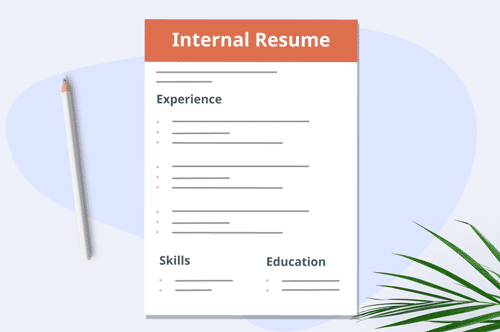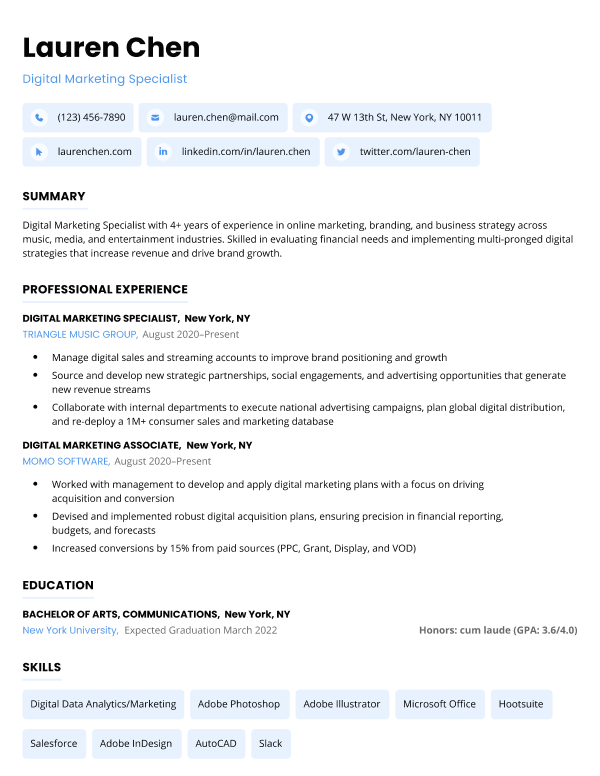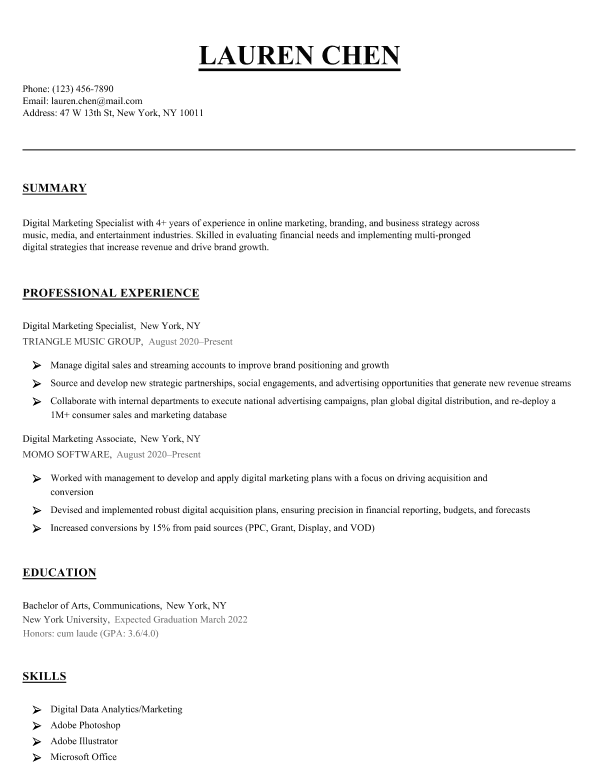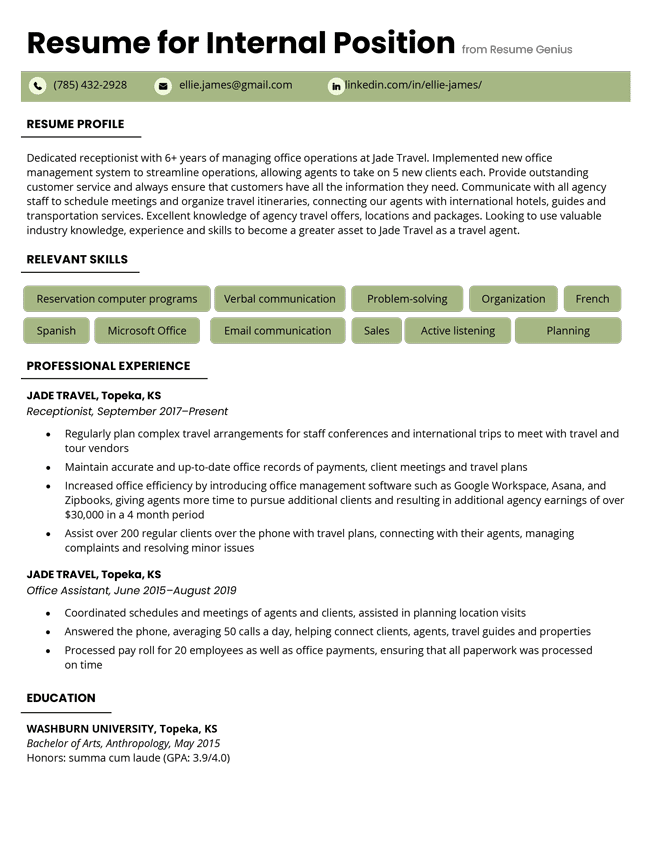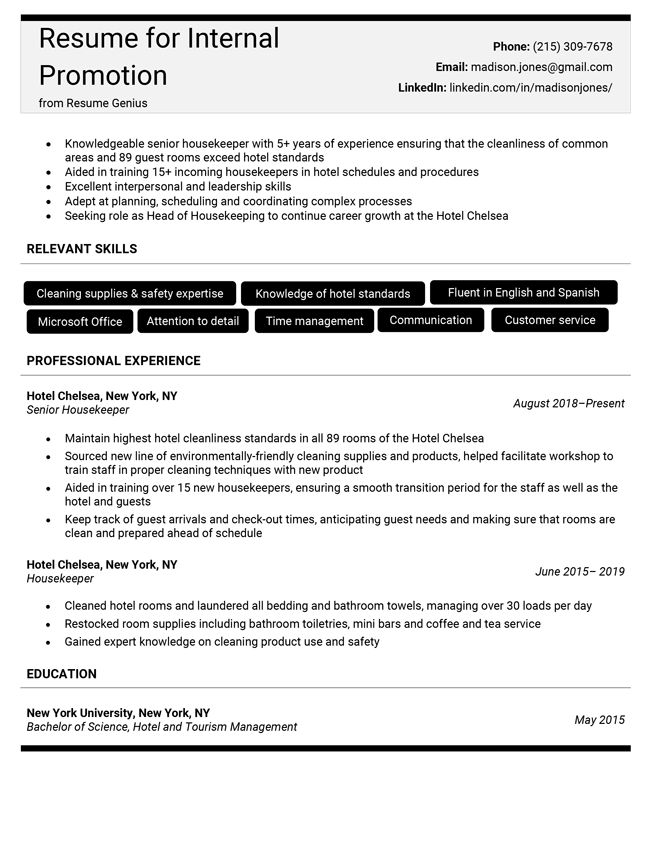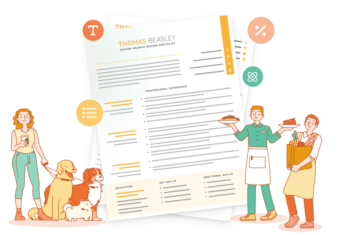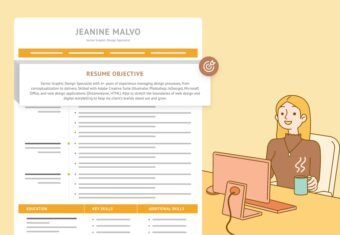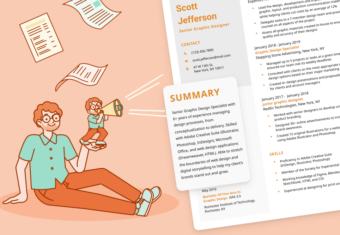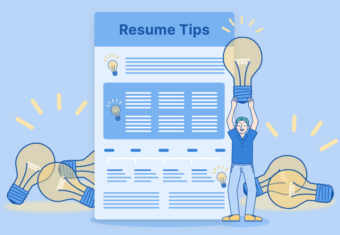Advancing your career doesn’t always mean looking for outside opportunities. Whether it’s a promotion, title change, or transfer, there are plenty of ways to grow your career within your current company.
Even if you’re applying for a new job with your current employer, you might still need to put together an application to formally apply for the new position.
Ready to learn more? Our career expert Eva explains what an internal resume is and how to write one:
If you’re applying for a promotion or job transfer, you’ll also likely need a cover letter for an internal position to nail down the job.
Read on to learn how to compose a resume for an internal position, complete with several examples.
Our free-to-use resume builder can make you a resume in as little as 5 minutes. Just pick the template you want, and our software will format everything for you.
What is an internal resume?
An internal resume is a resume targeted specifically to a job within your current company. If you’re applying for a promotion or for a job in a new department, you will likely need to submit an internal resume.
The primary focus of an internal resume is your professional experience over the course of your employment with the company. Like any resume, it should demonstrate to your employer that you’re the best fit for the open position.
Resume for internal position example
If you’re looking to take on a new role within your company or be transferred laterally to another department, it’s important to show your employer that you have the skills needed to fulfill the duties of that role.
Your internal resume should highlight your relevant and transferable skills, as well as your experience with the company you work at. The structure of a resume for an internal position is similar to a career change resume.
Here’s a resume example for an internal position:
Resume for internal promotion example
If you’re writing a resume for a promotion, then it’s important to demonstrate your competence in the skills and duties your new role will demand. In particular, you should highlight your management or leadership skills.
You also need to highlight all of your professional accomplishments from your current position.
Here’s an example of a resume for an internal promotion:
Internal resume template
Knowing how to write a resume is challenging, and it can feel daunting when you have to change the structure and form of your old resume.
When writing an internal resume, however, it’s best to start from scratch so that you can really focus on what’s important: your work with your current employer.
We’ve created the template below to help you visualize your internal resume structure and feel confident that you know what to include.
Internal Resume Template (Text Format)
FIRST AND LAST NAME
Email: your.email@gmail.com
Phone: (555)123-4567
Address: 123 Your Address, City, State, Zip
LinkedIn: linkedin.com/in/yourprofile
Professional Profile
[Job title] with [# of years] years of experience in [field]. Highly skilled in [relevant skills] with expertise in [top skill]. While at [company] managed to [quantifiable achievement]. Seeking to bring my leadership experience and [adjective] management style to [Company Name] as a [position name] to continue contributing to [company]’s goals.
Skills
- Include a bulleted list of your most relevant skills
- Add any certifications or licensure
- Use both hard and soft skills
Professional Experience
- Include a bulleted list that demonstrates what you’ve accomplished in your current role
- Quantify your work experience by adding hard numbers
- Highlight any achievements that show you’re ready for the new position you want
- Use past tense verbs to describe your accomplishments in a previous role
- Include only your most relevant and important achievements in 2-3 points
Education
How to write an internal resume
Writing a resume for an internal position differs from writing a traditional resume, so it’s important to make sure you know how to do it right.
Here’s how you can make sure your internal resume shows your employer that you’re ready for the next opportunity at your company:
Use a resume profile
Starting your resume strong is a great way to grab management’s attention. Using a resume profile gives you the opportunity to spotlight both your qualifications and career objectives.
A resume profile should include your:
- years of experience (or education)
- key accomplishments
- relevant skills
- career goals
A resume profile also offers a flexible style. It can be formatted as a short paragraph or as a bulleted list, depending on your preference.
Here is an example of a resume profile as a short paragraph:
Knowledgeable senior housekeeper with 5+ years of experience ensuring that the cleanliness of common areas and 89 guest rooms exceed hotel standards. Aided in training 15+ incoming housekeepers in hotel schedules and procedures. Excellent interpersonal and leadership skills, and adept at planning, scheduling and coordinating complex processes. Seeking role as Head of Housekeeping to continue career growth at the Hotel Chelsea.
Here’s the same resume profile formatted as a bulleted list:
- Knowledgeable senior housekeeper with 5+ years of experience ensuring that the cleanliness of common areas and 89 guest rooms exceed hotel standards
- Aided in training 15+ incoming housekeepers in hotel schedules and procedures
- Excellent interpersonal and leadership skills
- Adept at planning, scheduling and coordinating complex processes
- Seeking role as Head of Housekeeping to continue career growth at the Hotel Chelsea
A resume profile is very similar to a resume summary. To save time, consider using a resume summary generator to create an introduction quickly. Once you have your summary made, you can easily adjust the end result so it looks more like a resume profile.
Focus on your history with the company
The most significant way that an internal resume differs from a traditional resume is the type of experience you focus on.
Rather than focusing on any and all relevant experience, an internal resume requires a close examination of your professional history with your current company.
Before considering you for a promotion or a new opportunity, your employer wants to know what you’ve accomplished in your current and previous positions. If you can demonstrate that you’ve achieved tangible results and benefited the company, then you’re in a much stronger position to be seriously considered.
You can list your work experience as you would on a traditional resume, but instead of including past positions with other companies, include only the roles you’ve held with your current employer.
If you’ve held only one position, you can create a section such as “Key Achievements”, where you list your most notable accomplishments.
Quantify your accomplishments
When listing your work experience, it’s important to draw attention to tangible results you’ve achieved. Showing your employer that you’ve saved money or time, or increased profits or efficiency will make them view you as a beneficial fit for the role.
If you’re struggling to write an engaging work experience section, use more action verbs. Action verbs can transform dull, passive sentences into powerful, descriptive statements.
To quantify your accomplishments, present them using hard numbers wherever possible. Try to come up with at least two for each role you list. To get an idea for how to do this effectively, think of your role responsibilities in terms of measurable metrics like quantity, time, and money.
For example, instead of just saying that you were “responsible for managing the hotel’s laundry”, you could specify how many loads per day (on average), or how many rooms’ worth of linens you were responsible for.
Here are a couple more examples of how to quantify your resume:
Fielded an average of 40 phone calls per day, connecting over 300 regular clients with travel agents
Implemented a new training program for 25+ employees, resulting in an increase in customer satisfaction rates by 15% over 3 months
Highlight relevant skills
For employers screening potential candidates, a large part of the decision-making process stems from whether or not employees have the skills necessary to perform the duties required of the role.
Whether you’re seeking a promotion or looking to take on the challenge of an entirely different role at your company, it’s critical to emphasize you have the skills needed to excel in the new position.
Include a mix of hard and soft skills to demonstrate to employers that you have both the temperament and the technical prowess to handle the job.
To ensure that your employer knows just how talented you are, include skills in your resume profile and work experience sections in addition to your resume skills section.
Include your education
While your education section won’t be the focus of your internal resume, it’s good to include it at the end for reference.
Simply include the university, location, degree, and year graduated as you would in a traditional resume.
Here’s an example of how to format your education:
WASHBURN UNIVERSITY, Topeka, KS
Bachelor of Arts, Anthropology, May 2015
3 additional tips for writing internal resumes
Now you know how to write an internal resume. Before you get started we have a few additional tips that’ll help improve your chances of landing the job you want:
1. Do your research
Before you start writing your resume and cover letter for an internal position, it’s important to make sure that you know what the position you’re applying for entails so that you have a good idea of how to tailor your resume.
Do some research by talking to human resources, colleagues or those who work in the relevant department. Additionally, you could read up online about what the position usually involves and make sure you have the skills you need to do the job.
2. Target the position
You’re likely not the only candidate applying for this position internally. Your employer has other options, so it’s up to you to persuade them that you’re the best fit.
One of the best ways to do this is to use your resume and cover letter to target that specific position. If you can find a written job description, that will provide all the information you need regarding keys skills and responsibilities you need to highlight.
Scan the job description for industry-specific keywords to include in your resume. If there’s no job description available, consider asking the HR department to provide you with one.
By including specific skills and experience from the job description in your resume, you’ll demonstrate to your employer that you’re qualified to jump into the new position and immediately begin making valuable contributions.
3. Use your contacts
Networking is an important part of any job search, and it’s no different for internal applications. Talking to colleagues and getting recommendations from co-workers can be a powerful way to enhance your chances.
If other people within the company are recommending and endorsing you for the position, this sends a strong signal to your employer that you’re a valued team member who’s recognized for their work and that you possess the interpersonal skills it takes to become a leader.
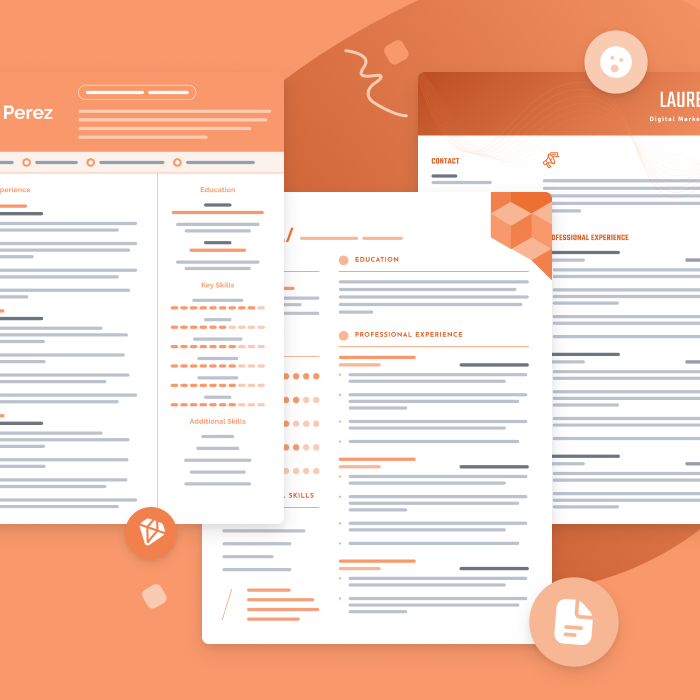
The best resume templates for 2024
One of the best ways to make your resume is by filling out one of our free resume templates. All our templates are designed by experts and free to download for Microsoft Word or Google Docs.
Click to rate this article
4.7 Average rating


